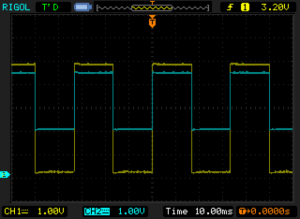When you need to buffer the output of an R-2R ladder or an RC filtered PWM signal, an op-amp is a single chip option. Unlike a discrete NPN transistor like a 2n3904, there is a lot going on inside of an LM741—or any op amp for that matter.
What if you could look inside of the op-amp? Wouldn’t it be cool to see how many transistors make up these small chips?
Put your electron microscope away. The XL741 from Evil Mad Scientist Labs is perfect for the job. I built one of these super fun solder kits and compared it to a real 741.
At the core, this is a soldering kit. You get an oversized PCB, all of the necessary parts, and a few mechanical pieces. For the record, I also built up the Three-Fives. That is a giant 555 chip it.
Every electronics geek owes it to themselves to have one of these on their bench. Not only are the designs functional, but they also look so cool.
Clean silk-screen identify each section of EMSL’s XL741 op-amp, which I like. So if you wanted to understand how operational amplifiers work, you could easily start poking around and see how different sub-circuits operate.
For my testing, I decided to build a simple voltage-follower. My intention was to buffer the output of an Arduino Pin, with the future intention of buffering the output of an RC-Filter.
Then I was suddenly hit with why there is one LM741 in my electronics kit and a bunch of LM358’s.
Performance

Channel 1 (Yellow) is the output of my function generator. Channel 2 (Blue) is the output of the XL741 configured as a voltage follower.
Notice something? Yeah, it doesn’t go all the way down to zero volts. So why is this 741 not going from 0 to VCC? Well, Here’s a scope capture of a real LM741.
Yup. That’s right, now I remember. LM741s suck as single-supply op-amps. For reference here is an LM358.
Regardless, the XL741 is performing much like the LM741.
Is the EMSL’s XL741 Worth it?
Discrete components crammed on a circuit board are no match for a single piece of silicon, in terms of performance. The kit is easy to build with clear instructions, labeled components, and a very highly quality printed circuit board (PCB).
The finished build is nothing short of gorgeous.
No question asked: 5 out of 5 LEDs.
![]()
Buy one of these XL741 kit or Three-Fives kit today. They are totally worth it.
Let’s Build the XL741
For Episode 16 of AddOhms, I remixed a Periscope live build of my XL741. Here’s what it looks like to build one:












2 Comments
I also try to review things I think are good. I was once given an ebook to review which I was not happy with so I kept postponing the review… That was 2 years ago, I should have been honest with the person and provided feedback but that does not have to be public.
That’s one reason I try not to review things “given” to me. I only review what I buy and use, which is why so many of my reviews are positive. If something is bad or flawed, I usually just move on. A friend pointed out “you don’t like everything, but you don’t give bad reviews.” I told them, “you might want to check my amazon account…”